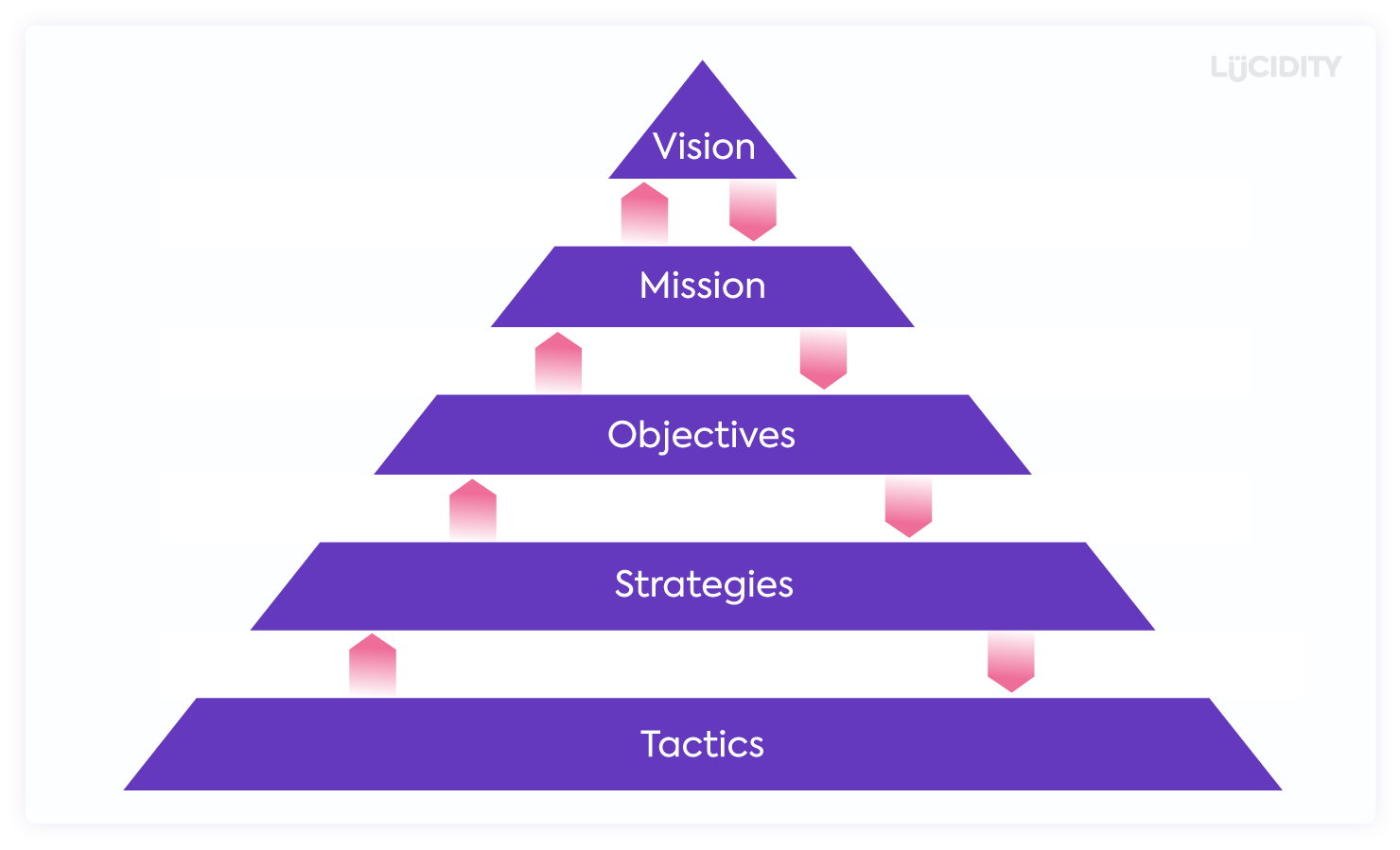VMOST is a tool designed to help you establish if all of your business activities are aligned to your strategy. Alignment is a key factor in ensuring a strategy is successful, so this can be a useful process to go through.
What is VMOST Analysis?
VMOST Analysis is a tool to evaluate if an overall strategy and supporting activities are in alignment. It can be used for your current strategy or future plans. The main benefit is breaking down a strategy and the core components into an easy to consume format.
VMOST stands for:
- Vision
- Mission
- Objectives
- Strategy
- Tactics
Presenting a strategy in this simple format allows teams to understand and identify any areas that are not aligned, as well as see where they fit within the business.
What is the difference between VMOST Analysis and MOST Analysis?
You may have heard of MOST Analysis and as you can probably guess by the antonym, VMOST differs because it incorporates Vision, where MOST does not. Apart from this, there’s no difference!
What is VMOST Analysis used for?
VMOST Analysis is used for:
- Communicating a strategy
- Structuring a strategic plan
- Getting feedback on strategic plans
- Checking the alignment of business units
You may also use VMOST for new strategic plans including:
- Defining new strategies
- Testing out new strategies
How do I complete a VMOST Analysis?
The process to completing a VMOST Analysis is simple but, if done well, will take you some time. That’s understandable though as you’re mapping out your strategy, getting it right is therefore important…
You’ll be completing VMOST for either your current strategy or a future strategy, and it may be at a company level or at a department level.
Step 1: Prepare and Research
It’s important with VMOST that you’re aware of the wider environment and the things that may impact your strategy. Consider completing a SWOT Analysis and, ideally, a PESTLE & Five Forces to give a wide view.
Step 2: Develop a Vision Statement
We’ll start with the V in VMOST which stands for Vision. Your Vision is the sentence that describes the future, that inspires and engages your team, and that spearheads why you exist. Check out our guide to Vision Statements for more on this topic.
Step 3: Develop a Mission Statement
The M in VMOST stands for Mission, the next logical step once your Vision is complete. A Mission Statement explains what you do and how you achieve that Vision. You can read more over in our guide to Mission Statements.
Step 4: Develop your Objectives
The O in VMOST is where a lot of the substantial parts of your strategy begin to form. The O stands for Objectives, these are the large items you wish to achieve. They’re big, bold, ambitious and clear. Consider how your Mission will become a reality and work from there. If you need help, take a look at our guide to Strategic Objectives for more on this topic.
Step 5: Develop your Strategies
This can be confusing in terms of naming convention. The S in VMOST stands for Strategies, but aren’t you developing a strategy in the first place?
It’s best to consider these as the smaller decisions you’re making to support your overall vision. So for example you may have a strategic objective of Customer Growth, with a goal of 5,000 customers by a certain date.
You may have a number of initiatives that support this objective. It could be things like “Offer a seasonal promotion” or “Develop new partner channels”, both of which could support that Customer Growth objective. In Lucidity we call these Initiatives, in VMOST they’re termed strategies.
This part of the VMOST process can take the longest as you’re listing the number of strategies/initiatives that have to occur in order to hit your objective and goals. At this point in the process the strategies/initiatives are still reasonably high level, and you can, of course, have multiple strategies/initiatives per objective.
Step 6: Develop your Tactics
This is the last step in the process of VMOST, with the T standing for Tactics. Tactics relate to the more detailed implementation of each of your strategies/initiatives in the plan.
Begin by listing out your strategies and going through each one. Identify what needs to happen to make the strategy a reality, including the details that may have been missed at the higher level.
For example, let’s look at a software company which has “International growth” as a strategy/initiative that supports the objective of Financial Growth. Below this they may include several tactics including:
- Develop a new language version of their software
- Open office in selected country
- Hire team
- Translate sales collateral
- Develop new case studies
Tactics can be smaller projects – such as Hire Team – or they could be individual tasks. It’s important each tactic has an owner, someone responsible and accountable for this element of the overall strategy.
Step 7: Pause & Review
You’ve completed your VMOST Analysis for a particular strategy, so it’s now time to review it as a whole. Ask yourself the following questions:
- Do the tactics at the bottom all line up towards the Vision?
- Is any part of the flow broken, or missing?
- If the Tactics are all complete, will the Strategies be finished?
- If the Strategies are all finished, will the Objectives all be done?
- If the Objectives are all done, is the Mission a reality?
- If the Mission is a reality, does the Vision become true?
If you’re happy with the VMOST Analysis and alignment is done, then you can repeat the process for as many strategic plans as you wish. Consider using something like the SFA Matrix now to score your options.
What are the advantages of VMOST Analysis?
The advantages of VMOST Analysis are:
- A clean and simple structure to follow
- It can be helpful when communicating strategy
- Teams using it all understand the direction and focus
- Misalignment becomes clearer and so can be removed
What are the disadvantages of VMOST Analysis?
The disadvantages of VMOST Analysis are:
- There’s no formal scoring method if used to compare different strategies to decide on the right approach
- It requires other tools in order to be useful
What tools work well with VMOST Analysis?
As VMOST Analysis is used commonly to map strategies out there are a few tools that complement it. In order to create a strategic option you may consider something like the Ansoff Matrix to generate ideas, while the SFA Matrix can help you score potential strategic plans.
Regardless of if you’re using VMOST for your current or new strategy, you should be doing it in conjunction with tools that help you understand the wider environment. It’s therefore useful to use something that maps external factors, perhaps a PESTLE or Five Forces, before bringing it in line with your internal attributes through a SWOT or TOWS.
What are the alternatives to VMOST Analysis?
VMOST is a method to display your strategy as a ‘one pager’, so has a lot in common with tools such as the Strategy Map.
Who invented V-MOST Analysis?
V-MOST Analysis was first developed by Rakesh Sondhi in his book Total Strategy, published in 1999.













